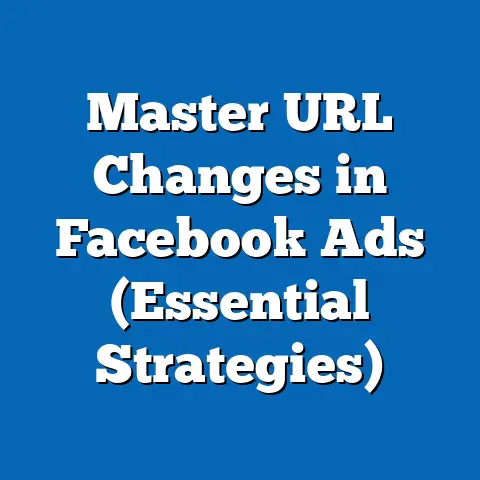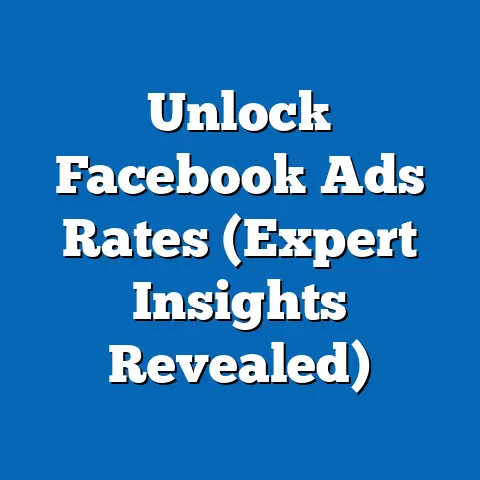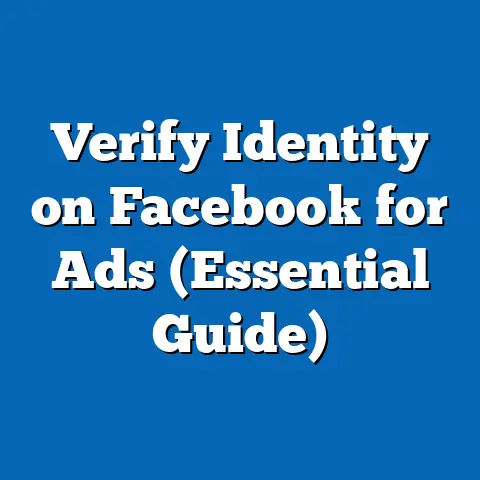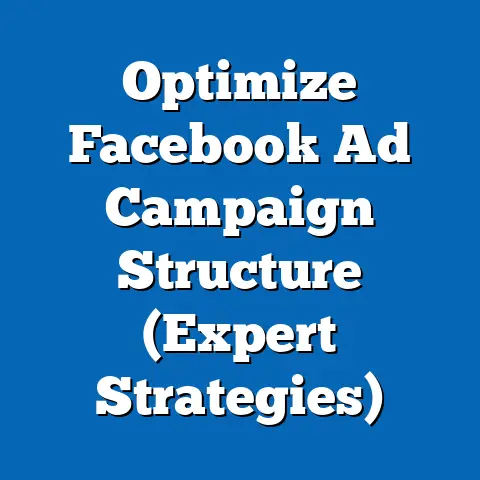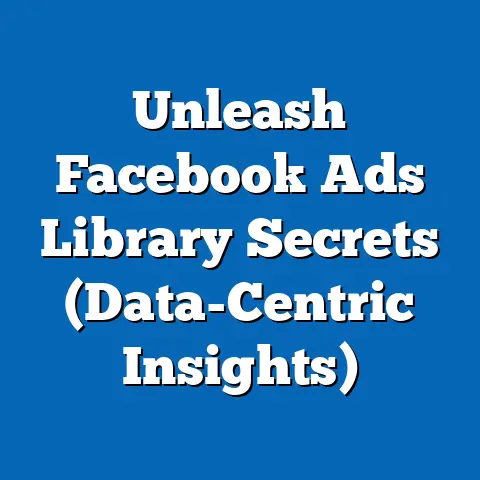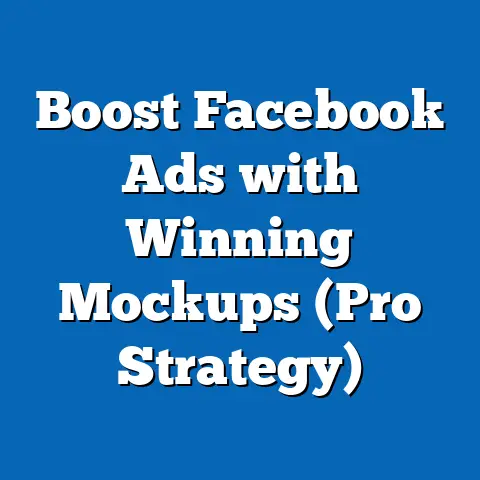Boost Facebook Ads with Irresistible Copy (Pro Tips)
I’ve always believed that truly effective marketing isn’t just about algorithms and data, it’s about understanding the human element. Craftsmanship, to me, goes beyond simply possessing a skill. It’s about the dedication, the passion, and the meticulous attention to detail that transforms a simple task into an art form. And nowhere is this more relevant than in the world of copywriting for Facebook ads.
In today’s digital landscape, where attention spans are fleeting and competition is fierce, compelling ad copy is the key to cutting through the noise and capturing your audience’s interest. It’s about understanding your audience, speaking their language, and crafting a message that resonates with their needs and desires. It’s about taking the time to hone your craft, experimenting with different techniques and styles until you find the perfect combination that drives results.
This isn’t just about writing words; it’s about crafting experiences. It’s about understanding the psychology behind what makes people click, share, and ultimately, convert. So, let’s dive into the world of crafting irresistible Facebook ad copy and discover how you can boost your campaigns with words that truly connect.
Section 1: Understanding Your Audience
Before even thinking about writing a single word, you need to know who you’re talking to. Imagine trying to sell snow to someone living in the Arctic – that’s what ineffective targeting feels like.
1. Identify Target Demographics
The foundation of any successful Facebook ad campaign lies in understanding your target audience. Who are they? What are their ages, genders, locations, and interests? These demographic details are crucial for tailoring your ad copy to resonate with the right people.
Facebook offers a powerful tool called Audience Insights that can help you gather this information. It allows you to analyze the demographics, interests, behaviors, and lifestyles of people on Facebook. I remember when I first started using Audience Insights, I was blown away by the sheer amount of data available. I could see everything from the pages people liked to the devices they used to access Facebook.
Here’s how to use Facebook Audience Insights:
- Access Audience Insights: Go to your Facebook Ads Manager and navigate to the “Tools” menu. Select “Audience Insights.”
- Choose Your Audience: You can choose to analyze “Everyone on Facebook” or “People Connected to Your Page.” If you’re just starting, “Everyone on Facebook” is a good option to get a broad overview.
- Refine Your Audience: Use the filters on the left-hand side to narrow down your audience based on demographics, interests, behaviors, and more.
- Analyze the Data: Pay attention to the insights provided by Facebook. Look for patterns and trends that can inform your ad copy.
Key Takeaway: Don’t guess your audience. Use Facebook Audience Insights to gather concrete data and build a clear picture of who you’re trying to reach.
2. Pain Points and Desires
Once you know who your audience is, you need to understand what motivates them. What are their pain points? What are their desires? What keeps them up at night?
Understanding these pain points and desires is crucial for crafting ad copy that resonates with your audience on an emotional level. When you address their concerns and offer solutions, you’re more likely to capture their attention and drive them to take action.
Here’s how to identify the pain points and desires of your audience:
- Conduct Surveys and Polls: Use tools like SurveyMonkey or Google Forms to ask your audience directly about their challenges and aspirations.
- Read Reviews and Testimonials: Analyze what customers are saying about your products or services (or your competitors’ products or services). What problems are they solving? What benefits are they experiencing?
- Monitor Social Media: Pay attention to conversations happening on social media platforms related to your industry or niche. What are people complaining about? What are they excited about?
- Engage with Your Audience: Respond to comments and messages on your social media channels. Ask questions and listen to their feedback.
Example:
Let’s say you’re selling a time management app. You might discover that your target audience is struggling with:
- Pain Points: Feeling overwhelmed, missing deadlines, struggling to balance work and personal life.
- Desires: Feeling more organized, being more productive, having more free time.
With this information, you can craft ad copy that speaks directly to these pain points and desires. For example:
- Headline: “Stop Feeling Overwhelmed: Take Control of Your Time with [App Name]”
- Body Copy: “Are you tired of missing deadlines and feeling like you never have enough time? [App Name] helps you get organized, stay focused, and achieve your goals.”
Key Takeaway: Understand your audience’s pain points and desires, and use that knowledge to craft ad copy that speaks directly to their needs.
3. Creating Buyer Personas
To truly understand your audience, it’s helpful to create detailed buyer personas. A buyer persona is a semi-fictional representation of your ideal customer based on research and data about your existing and potential customers.
Creating buyer personas helps you:
- Visualize Your Audience: It puts a face to your target audience and makes them more relatable.
- Tailor Your Messaging: It helps you craft ad copy that speaks directly to the needs and desires of your ideal customer.
- Improve Targeting: It helps you refine your targeting options on Facebook to reach the right people.
Here’s how to create a buyer persona:
- Give Your Persona a Name: This helps you humanize your persona and make them more relatable.
- Include Demographic Information: Age, gender, location, occupation, income, education level, etc.
- Describe Their Goals and Challenges: What are they trying to achieve? What obstacles are they facing?
- Identify Their Values and Fears: What’s important to them? What are they afraid of?
- Describe Their Online Behavior: What social media platforms do they use? What websites do they visit?
- Include a Quote: Add a quote that captures their personality and motivations.
Example:
Let’s say you’re selling a fitness program. Your buyer persona might look like this:
- Name: Sarah
- Age: 35
- Occupation: Marketing Manager
- Goals: To lose weight, get in shape, and feel more confident.
- Challenges: Doesn’t have much time to exercise, struggles to stay motivated, and finds it difficult to eat healthy.
- Quote: “I just want to feel good about myself again.”
With this buyer persona in mind, you can craft ad copy that speaks directly to Sarah’s needs and desires. For example:
- Headline: “Busy Mom Loses 20 Pounds in 8 Weeks with Our Simple Fitness Program”
- Body Copy: “Sarah was tired of feeling sluggish and out of shape. Our program helped her lose weight, get in shape, and feel more confident, even with her busy schedule.”
Key Takeaway: Create detailed buyer personas to visualize your ideal customers and craft ad copy that speaks directly to their needs and desires.
Section 2: The Fundamentals of Irresistible Copy
Once you understand your audience, it’s time to start crafting your ad copy. But not just any copy – irresistible copy that grabs attention, sparks interest, and drives action.
1. Crafting Compelling Headlines
Your headline is the first thing people see, so it needs to be attention-grabbing and intriguing. It’s your chance to make a first impression and convince people to stop scrolling and learn more.
Here are some strategies for writing compelling headlines:
- Use Numbers and Statistics: Numbers are attention-grabbing and add credibility. For example, “5 Ways to Boost Your Productivity” or “90% of Our Customers See Results in 30 Days.”
- Ask a Question: Questions pique curiosity and encourage people to click. For example, “Are You Making These Common Mistakes?” or “Do You Want to Learn a New Skill?”
- Use Power Words: Power words are emotionally charged words that evoke a strong response. For example, “Amazing,” “Secret,” “Proven,” “Ultimate,” “Free.”
- Create a Sense of Urgency or Scarcity: Urgency and scarcity motivate people to take action now. For example, “Limited Time Offer” or “Only 10 Spots Left.”
- Address a Specific Pain Point or Desire: As discussed earlier, speaking directly to your audience’s needs is a powerful way to grab their attention.
Examples of Effective Headlines:
- “The Secret to Writing Headlines That Convert”
- “Learn a New Language in Just 30 Days”
- “Free Guide: How to Double Your Website Traffic”
- “Limited Time Offer: 50% Off All Products”
- “Are You Making These Common Facebook Ad Mistakes?”
Why They Work:
- The Secret to Writing Headlines That Convert: Uses a power word (“Secret”) and promises a valuable benefit (converting headlines).
- Learn a New Language in Just 30 Days: Uses a specific timeframe and promises a desirable outcome.
- Free Guide: How to Double Your Website Traffic: Offers a valuable free resource and promises a tangible result.
- Limited Time Offer: 50% Off All Products: Creates a sense of urgency and offers a compelling discount.
- Are You Making These Common Facebook Ad Mistakes?: Asks a question that piques curiosity and addresses a potential pain point.
Key Takeaway: Your headline is your first impression. Make it count by using numbers, power words, questions, urgency, or by addressing a specific pain point or desire.
2. The Importance of a Strong Hook
A strong hook is essential for drawing the reader in and keeping them engaged. It’s the bridge between your headline and the rest of your ad copy.
Here are some techniques for creating a hook that resonates with the audience’s emotions or needs:
- Tell a Story: Start with a compelling anecdote or personal story that relates to your product or service.
- Ask a Provocative Question: Pose a question that challenges the reader’s assumptions or beliefs.
- Make a Bold Statement: Start with a surprising or controversial claim that grabs attention.
- Offer a Solution to a Common Problem: Immediately address a pain point that your audience is experiencing.
- Highlight a Unique Benefit: Showcase a feature or advantage that sets your product or service apart.
Example:
Let’s say you’re selling a productivity tool. Here are some examples of strong hooks:
- Story: “I used to struggle to stay organized and meet deadlines. Then I discovered [Product Name], and it changed my life.”
- Provocative Question: “Are you tired of wasting time on unproductive tasks?”
- Bold Statement: “The average person wastes 2 hours a day on distractions.”
- Solution to a Common Problem: “Feeling overwhelmed? [Product Name] helps you prioritize tasks and stay focused.”
- Unique Benefit: “[Product Name] is the only productivity tool that integrates with all your favorite apps.”
Key Takeaway: Your hook is the key to keeping your audience engaged. Use storytelling, provocative questions, bold statements, or highlight a unique benefit to draw them in.
3. Utilizing Storytelling
Storytelling is a powerful tool for connecting with your audience on an emotional level. People are naturally drawn to stories, and they’re more likely to remember information that’s presented in a narrative format.
Here are some tips on weaving anecdotes or customer stories into ad copy:
- Focus on the Human Element: Make your stories relatable and authentic by focusing on the emotions, challenges, and triumphs of real people.
- Keep it Concise: Your stories should be brief and to the point. Aim for a length of 1-3 sentences.
- Highlight the Benefits: Show how your product or service helped the protagonist overcome their challenges and achieve their goals.
- Use Vivid Language: Paint a picture with your words and engage the reader’s senses.
- Include a Call to Action: End your story with a clear call to action that encourages the reader to take the next step.
Example:
Let’s say you’re selling a travel agency. Here’s an example of how to use storytelling in your ad copy:
- “Sarah had always dreamed of visiting Italy, but she didn’t know where to start. Our travel experts helped her plan the perfect trip, from booking flights and hotels to arranging tours and activities. She returned home with memories that will last a lifetime.”
Key Takeaway: Storytelling is a powerful way to connect with your audience on an emotional level. Use anecdotes and customer stories to make your ad copy more relatable and memorable.
Section 3: Writing Techniques for Engagement
Now that you have the fundamentals down, let’s explore some specific writing techniques that can boost engagement and drive results.
1. Using Persuasive Language
Persuasive language is the art of using words to influence your audience’s thoughts, feelings, and behaviors. It’s about understanding the psychology of persuasion and using techniques that make your ad copy more compelling and convincing.
Here are some persuasive language techniques you can use in your Facebook ads:
- Social Proof: Use testimonials, reviews, and statistics to show that other people have had positive experiences with your product or service. For example, “Join over 10,000 satisfied customers” or “Rated 5 stars by our users.”
- Urgency: Create a sense of urgency by highlighting limited-time offers, deadlines, or scarcity. For example, “Limited Time Offer: Ends Tonight!” or “Only 10 Spots Left.”
- Scarcity: Emphasize the limited availability of your product or service to create a sense of exclusivity. For example, “Limited Edition” or “While Supplies Last.”
- Authority: Establish yourself as an expert in your field by sharing your knowledge, expertise, and credentials. For example, “As Seen On [Media Outlet]” or “Certified by [Industry Organization].”
- Reciprocity: Offer something of value to your audience in exchange for their attention or business. For example, “Download our free guide” or “Get a free consultation.”
Examples of Phrases That Enhance Persuasive Quality:
- “Proven Results”
- “Guaranteed Satisfaction”
- “Exclusive Offer”
- “Limited Time Only”
- “Don’t Miss Out”
- “Join the Thousands Who Have Already Benefited”
Key Takeaway: Use persuasive language techniques like social proof, urgency, scarcity, authority, and reciprocity to make your ad copy more compelling and convincing.
2. Incorporating Calls to Action (CTAs)
Your call to action (CTA) is the final nudge that encourages your audience to take the desired action. It should be clear, concise, and compelling, and it should tell people exactly what you want them to do.
Here are some tips for writing effective CTAs:
- Use Action Verbs: Start your CTA with a strong action verb that tells people what to do. For example, “Shop Now,” “Learn More,” “Sign Up,” “Download,” “Get Started.”
- Be Specific: Tell people exactly what they’ll get when they click your CTA. For example, “Shop Now and Save 50%” or “Download Your Free Guide.”
- Create a Sense of Urgency: Use words like “Now,” “Today,” or “Limited Time” to encourage people to take action immediately.
- Make it Stand Out: Use a contrasting color or a larger font size to make your CTA more visible.
- Test Different CTAs: Experiment with different CTAs to see which ones perform best.
Examples of Effective CTAs:
- “Shop Now”
- “Learn More”
- “Sign Up for Free”
- “Download Your Free Ebook”
- “Get Started Today”
- “Claim Your Discount”
- “Book Your Appointment Now”
Why They Work:
- They use strong action verbs that tell people what to do.
- They are specific and tell people what they’ll get when they click.
- They create a sense of urgency.
- They are visually appealing and stand out from the rest of the ad copy.
Key Takeaway: Your CTA is the final nudge that encourages your audience to take action. Make it clear, concise, compelling, and visually appealing.
3. Formatting for Readability
In today’s fast-paced digital world, people are constantly bombarded with information. If your ad copy is difficult to read, people will simply scroll past it.
Here are some tips for formatting your ad copy for readability:
- Use Short Paragraphs: Break up your text into short, concise paragraphs that are easy to scan.
- Use Bullet Points: Use bullet points to highlight key information and make your ad copy more visually appealing.
- Use Whitespace: Leave plenty of whitespace around your text to make it easier to read.
- Use a Clear Font: Choose a font that is easy to read on both desktop and mobile devices.
- Use Visuals: Include images or videos to break up your text and make your ad copy more engaging.
Key Takeaway: Format your ad copy for readability by using short paragraphs, bullet points, whitespace, a clear font, and visuals.
Section 4: Ad Copy Testing and Optimization
Writing great ad copy is just the first step. To truly maximize your results, you need to test your copy and optimize it based on performance data.
1. A/B Testing Your Copy
A/B testing, also known as split testing, is the process of comparing two versions of your ad copy to see which one performs better. It’s a powerful way to identify what resonates with your audience and optimize your ad campaigns for maximum results.
Here’s how to A/B test your ad copy:
- Create Two Versions of Your Ad Copy: Change only one element at a time, such as the headline, body copy, or CTA.
- Run Your Ads: Run both versions of your ad copy simultaneously to the same audience.
- Track Your Metrics: Monitor the performance of each version of your ad copy, paying attention to metrics such as click-through rate (CTR), conversion rate, and cost per conversion.
- Analyze Your Results: Determine which version of your ad copy performed better and use that information to optimize your future ad campaigns.
What Metrics to Track:
- Click-Through Rate (CTR): The percentage of people who saw your ad and clicked on it.
- Conversion Rate: The percentage of people who clicked on your ad and completed the desired action (e.g., making a purchase, signing up for a newsletter).
- Cost Per Conversion: The amount of money you spent to generate one conversion.
Key Takeaway: A/B testing is a powerful way to identify what resonates with your audience and optimize your ad campaigns for maximum results.
2. Iterating Based on Feedback
In addition to A/B testing, you should also gather feedback from your audience to refine your ad copy. This can include reading comments on your ads, conducting surveys, or simply talking to your customers.
Here’s how to gather and analyze feedback from ad performance to refine copy:
- Read Comments on Your Ads: Pay attention to what people are saying about your ads in the comments section. Are they asking questions? Are they expressing concerns? Are they offering suggestions?
- Conduct Surveys: Use tools like SurveyMonkey or Google Forms to ask your audience directly about their thoughts on your ad copy.
- Talk to Your Customers: Ask your customers about their experience with your product or service and use that information to refine your ad copy.
Key Takeaway: Gather feedback from your audience to refine your ad copy and make it more relevant and effective.
3. Staying Updated with Trends
The world of Facebook advertising is constantly evolving, so it’s important to stay updated with the latest trends and best practices. This includes reading industry blogs, attending conferences, and experimenting with new features and strategies.
Here’s how to continuously educate yourself on effective copywriting and Facebook advertising:
- Read Industry Blogs: Subscribe to industry blogs like Social Media Examiner, MarketingProfs, and HubSpot to stay updated with the latest trends and best practices.
- Attend Conferences: Attend industry conferences like Social Media Marketing World and Content Marketing World to learn from experts and network with other marketers.
- Experiment with New Features and Strategies: Don’t be afraid to try new things. Test different ad formats, targeting options, and copywriting techniques to see what works best for your business.
Key Takeaway: Stay updated with the latest trends and best practices in Facebook advertising to ensure that your ad copy remains relevant and effective.
Section 5: Real-World Examples and Case Studies
Let’s take a look at some real-world examples of successful (and not-so-successful) Facebook ad campaigns to see what lessons we can learn.
1. Successful Facebook Ad Campaigns
Case Study 1: Dollar Shave Club
Dollar Shave Club is a subscription service that delivers razors and other grooming products to your door. Their Facebook ad campaigns are known for their humor, wit, and relatable messaging.
What Made Their Copy Effective:
- Humor: Their ads are funny and entertaining, which helps them stand out from the competition.
- Relatability: They speak directly to the pain points of their target audience (men who are tired of paying too much for razors).
- Simplicity: Their messaging is clear, concise, and easy to understand.
Case Study 2: Airbnb
Airbnb is a platform that connects travelers with hosts who offer unique accommodations around the world. Their Facebook ad campaigns showcase stunning visuals of their properties and highlight the unique experiences that travelers can have when they book with Airbnb.
What Made Their Copy Effective:
- Visuals: Their ads feature high-quality photos and videos that showcase the beauty and uniqueness of their properties.
- Storytelling: They tell stories about the experiences that travelers can have when they book with Airbnb.
- Targeting: They target their ads to people who are interested in travel and specific destinations.
Key Takeaway: Successful Facebook ad campaigns often feature a combination of humor, relatability, simplicity, stunning visuals, storytelling, and targeted messaging.
2. Learning from Failures
Example 1: Overly Salesy Ad Copy
An ad that focuses solely on pushing a product or service without addressing the audience’s needs or providing value is likely to fail.
What Went Wrong:
- Lack of Focus on the Audience: The ad copy was all about the product and didn’t address the audience’s pain points or desires.
- Pushy Sales Tactics: The ad copy used aggressive sales tactics that turned people off.
- Lack of Credibility: The ad copy made unsubstantiated claims that lacked credibility.
Example 2: Generic Ad Copy
An ad that uses generic language and doesn’t differentiate itself from the competition is likely to get lost in the noise.
What Went Wrong:
- Lack of Specificity: The ad copy was too general and didn’t provide any specific details about the product or service.
- Lack of Uniqueness: The ad copy didn’t differentiate itself from the competition.
- Lack of Engagement: The ad copy was boring and didn’t engage the audience.
Key Takeaway: Avoid overly salesy or generic ad copy. Focus on addressing the audience’s needs, providing value, and differentiating yourself from the competition.
Conclusion
Craftsmanship in Facebook advertising is about more than just writing words. It’s about understanding your audience, speaking their language, and crafting a message that resonates with their needs and desires.
By following the tips and techniques outlined in this guide, you can master the art of copywriting and boost your Facebook ads with powerful, engaging copy that drives results.
Remember, mastering the art of copywriting is an ongoing journey. Embrace the process of experimentation, learning, and refining your skills. Stay curious, stay creative, and never stop striving to craft irresistible ad copy that captivates your audience and drives them to take action.

